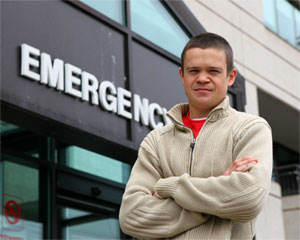 |
| Andre Maddison is a master's student in Community Health and Epidemiology. (Nick Pearce Photo) |
Just like on ER, emergency rooms are increasingly overcrowded and chaotic. Emergency department overcrowding has been a pressing issue in Canada for the last two decades.
The question is, why? The common belief is that primary care, or non-urgent patientsâpeople with nagging colds, flu or minor achesâare causing this overcrowding.
Andre Maddison wasnât sure what exactly was causing the problem, but he didnât think primary care patients were at its core. The masterâs student in Community Health and Epidemiology investigated this popular misconception and by doing so, became one of two winners of the Canadian Health Services Research Foundationâs 2009 Mythbusters Award.
âThe award was definitely a surprise,â says Mr. Maddison. âI was able to attend the CHSRF annual conference in Calgary and met the who's who in the Canadian health world â for a nerdy health-care student it was an exciting experience.â
âItâs a really great award and I couldnât have accomplished this without the assistance I received from professor Yukiko Asada,â says Mr. Maddison. âShe helped me a lot with the paper, even after the course was over.â
Mythbusters is a series is run by the CHSRF and is published differently than most medical publications â using plain language free of medical jargon that everyone can understand. Other myths explored in earlier issues include the myth that Canadian doctors are leaving for the U.S. in droves and that generic drugs are lower quality and less safe than brand-name drugs.
The CHSRF asked students across the country to submit their findings as part of a national competition. Already required for his coursework, Mr. Maddison decided to submit his research. The winners were selected based on the myth they busted and their defence of it.
âI started with the view that due to a shortage of family doctors, people are going to emergency departments and overcrowding them,â explains Mr. Maddison, a native of Sarnia, Ont. âBut in reality, why EDs are overcrowded wasn't known.â
While 40 to 50 per cent of cases in the ER are non-urgent patients, after extensive literature research and speaking with physicians, Mr. Maddison found that primary-care patients were not overly burdensome. His research illustrated that patients in urgent need of acute-care, admitting beds, extended stay, specialists and other high demand care needs actually have a greater impact on overcrowding. âWe canât discount the affect of so many non-urgent patients, but they are certainly not the main part of the problem.â
Mr. Maddison believes itâs a system-wide problem, not isolated to the ED. âEmergency department overcrowding is a national problem with potentially devastating effects,â he says. âIt is rooted in insufficient physical and human resources and poor integration within and between hospitals.â He went on to say that to best care for both urgent and non-urgent patients effectively, we must determine the purpose of EDs in order to best serve the patients, health-care professionals, communities and the country.
During the summer, Mr. Maddison will work with the CHSRF to polish up his paper before it goes to publication. He hopes it helps people, especially policymakers, to better understand the fundamental problems of overcrowding.
At 25, Mr. Maddison is studying access to care in Nova Scotia, particularly access to colorectal cancer services in the province and will graduate next spring. An avid cyclist who travels Nova Scotia on day-long bike trips to places like Peggyâs Cove, Mr. Maddison recommends other students attempt to tackle other myths in Canadian health care. âEvery student should learn to write in that manner and help give greater clarity to the health care system.â
LINK:
